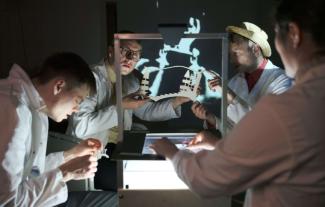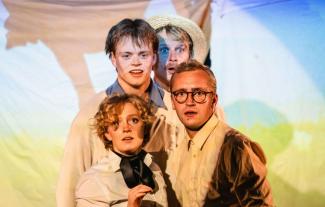Play review: The Animator

Olga Oryema shares her thoughts on the play The Animator, which incorporated one of its actor's stammers into the story.
On Thursday 21st August, I attended a showing of The Animator, presented by Akimbo Theatre, at Southwark Playhouse Borough in London.
The play started off with an old German woman visiting the British Film Institute in the early 1970s to obtain a copy of a film from the 1920s. The film in question was The Adventures of Prince Achmed , the very first animated feature film, and the woman was Lotte Reiniger, who created it.
This adventurous innovator and her quirky crew are brought to life in The Animator as they create the first animation tables, entice financiers, fall in love and defend their craft.
I sat in the front row and was immediately drawn to how small the set was — its intimacy was fascinating. The actors assembled around an antiquated overhead projector (see above) that is connected to a big screen that forms the stage's rear. I enjoyed seeing how so much can happen on such a small stage. The tale was intricate and captivating, and it was conveyed in a distinctive manner, featuring occasionally-employed unexpected stage combat in addition to a physical narrative through dance and movement.
Integrating stammering
Halvor Tangen Schultz, who played the German film director Carl Koch (and love interest to Lotte), had his stammer become part of his role. In the article he wrote for this site, 'Integrating my stammer into acting', he told STAMMA:
"Another advantage of this way of working is that many of the actors' unique abilities, quirks or accents naturally become part of the final script, so my stammer becomes part of my characters. We found many moments of play with my stammer, discovering which characters interrupt him and who lets him carry on speaking, as well as moments of suspense as he finishes complex technical explanations.”

It was interesting to see how his stammer was incorporated into the play in a creative manner but also reflects how those with a stammer are treated, from being interrupted to being given the time to finish his sentences.
Akimbo Theatre offered a high-octane physical theatre narrative with dark political themes set against this shifting landscape of light and shadow, which served as an unnerving mirror to current affairs. The ensemble gave the performance their all, including dancing, slapstick and caricature. I long to go back to the studio scenes, where their work was slickly shown on a screen, offering enticing snippets of art.
The play used music, humour, puppetry, political commentary and dance to illustrate Reiniger's ability to animate paper silhouettes to create fairy tales on film. When paired with the final animation, the result looked truly amazing. Towards the end, we witnessed a prince sailing across the storm-tossed Arabian seas in a poignant and enthralling moment of amazement and connection. Nevertheless, it is clear how one woman changed the world of animation forever.
Thank you to Olga for reviewing this play for STAMMA.
































